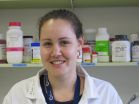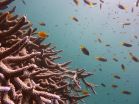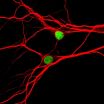New molecules to burst malaria's bubble: ANU media release
Scientists have released details of a raft of new chemicals with potent anti-malarial properties which could open the way to new drugs to fight the disease
2014-12-03
(Press-News.org) Scientists have released details of a raft of new chemicals with potent anti-malarial properties which could open the way to new drugs to fight the disease.
A new paper in PNAS is the third published by the group at the Australian National University (ANU), which has collaborated with groups from around the globe to uncover potential ammunition in the fight against malaria.
Over 200 million people contract malaria each year, and the parasite that causes the disease has become resistant to most of the drugs currently available.
"The papers show the malaria parasite has real Achilles heel, and we now have range of new ways to attack it," said Professor Kiaran Kirk, Dean of the College of Medicine, Biology and Environment and one of the scientists involved in the project.
Dr Natalie Spillman, from the Research School of Biology at ANU studied the mechanism by which the parasites are killed.
"All of the new molecules block a molecular salt pump at the surface of the parasite, which causes it to fill up with salt," Dr Spillman said
"This has the effect of drawing water into the parasite, causing it to swell uncontrollably and burst."
Although the process of developing the new compounds into a clinical drug is complex and lengthy, Professor Kirk is optimistic the findings will lead to new treatments.
"It's very early days, but these pump-blocking compounds have some of the most promising anti-malarial potential we've seen," he says.
Aspects of the work were carried out with groups at Griffith University, Monash University and the Menzies School of Health Research in Darwin.
"This is a good example of a long-term, international drug development program in which Australian groups have played a key role," he said.
INFORMATION:
[Attachments] See images for this press release:

ELSE PRESS RELEASES FROM THIS DATE:
2014-12-03
A glimmer of hope for corals as baby reef builders cope with acidifying oceans
While the threat of coral bleaching as a result of climate change poses a serious risk to the future of coral reefs worldwide, new research has found that some baby corals may be able to cope with the negative effects of ocean acidification.
Ocean acidification, which is a direct consequence of increased atmospheric carbon dioxide levels, is expected to have a deleterious effect on many marine species over the next century.
An international team examining the impact of ocean acidification ...
2014-12-03
Coral reefs provide a range of benefits, such as food, opportunities for income and education, but not everyone has the same access to them, according to a new study conducted by the ARC Centre of Excellence for Coral Reef Studies (Coral CoE) at James Cook University.
The researchers examined how people from 28 fishing communities in Madagascar, Kenya, Tanzania and Seychelles benefit from the marine environment.
For many years conservation in developing countries has been based on the assumption that improvements in ecosystem conditions, such as increasing coral reef ...
2014-12-03
December 3, 2014 -- Individuals conceived in the severe Dutch Famine, also called the Hunger Winter, may have adjusted to this horrendous period of World War II by making adaptations to how active their DNA is. Genes involved in growth and development were differentially regulated, according to researchers at the Leiden University Medical Center, Harvard University, and Columbia University's Mailman School of Public Health. Findings are published in the journal Nature Communications.
During the winter of 1944-1945 the Western part of The Netherlands was struck by a severe ...
2014-12-03
CHAPEL HILL, NC - UNC School of Medicine researchers have found for the first time a biochemical mechanism that could be a cause of "chemo brain" - the neurological side effects such as memory loss, confusion, difficulty thinking, and trouble concentrating that many cancer patients experience while on chemotherapy to treat tumors in other parts of the body.
The research, published in the Proceedings of the National Academy of Sciences, shows how the common chemotherapy drug topotecan can drastically suppress the expression of Topoisomerase-1, a gene that triggers the ...
2014-12-03
Coffee, apple juice, and vitamin C: things that people ingest every day are experimental material for chemist Eva-Maria Felix. The doctoral student in the research group of Professor Wolfgang Ensinger in the Department of Material Analysis is working on making nanotubes of gold. She precipitates the precious metal from an aqueous solution onto a pretreated film with many tiny channels. The metal on the walls of the channels adopts the shape of nanotubes; the film is then dissolved. The technique itself is not new, but Felix has modified it: "The chemicals that are usually ...
2014-12-03
WASHINGTON, D.C., December 3, 2014--A new report from the American Institute of Physics (AIP) Statistical Research Center has found that the number of Hispanic students receiving bachelor's degrees in the physical sciences and engineering has increased over the last decade or so, passing 10,000 degrees per year for the first time in 2012. The overall number of U.S. students receiving degrees in those fields also increased over the same time, but it increased faster among Hispanics.
From 2002 to 2012, the number of Hispanics earning bachelor's degrees in the physical sciences ...
2014-12-03
TALLAHASSEE, Fla. -- A team led by Florida State University researchers has identified DNA elements in maize that could affect the expression of hundreds or thousands of genes.
"Maybe they are part of the machinery that allows an organism to turn hundreds of genes off or on," said Associate Professor of Biological Science Hank Bass.
Bass and Carson Andorf, a doctoral student in computer science at Iowa State University, began this exploration of the maize genome sequence along with colleagues from FSU, Iowa State and the University of Florida. They wanted to know ...
2014-12-03
New York, NY, December 2, 2014 - Immediate breast reconstruction following mastectomy is becoming more prevalent. However, in breast cancer patients undergoing simultaneous chemotherapy, thrombotic complications can arise that can delay or significantly modify reconstructive plans. Outcomes of cases illustrating potential complications are published in the current issue of Annals of Medicine and Surgery.
Chemotherapy is increasingly used to treat larger operable or advanced breast cancer prior to surgery. Chemotherapy delivered via the placement of a central venous line ...
2014-12-03
Hamilton, ON (Dec. 3, 2014) - Scientists at McMaster University have discovered that human stem cells made from adult donor cells "remember" where they came from and that's what they prefer to become again.
This means the type of cell obtained from an individual patient to make pluripotent stem cells, determines what can be best done with them. For example, to repair the lung of a patient with lung disease, it is best to start off with a lung cell to make the therapeutic stem cells to treat the disease, or a breast cell for the regeneration of tissue for breast cancer ...
2014-12-03
CAMBRIDGE, MA -- MIT biological engineers have created a new computer model that allows them to design the most complex three-dimensional DNA shapes ever produced, including rings, bowls, and geometric structures such as icosahedrons that resemble viral particles.
This design program could allow researchers to build DNA scaffolds to anchor arrays of proteins and light-sensitive molecules called chromophores that mimic the photosynthetic proteins found in plant cells, or to create new delivery vehicles for drugs or RNA therapies, says Mark Bathe, an associate professor ...
LAST 30 PRESS RELEASES:
[Press-News.org] New molecules to burst malaria's bubble: ANU media release
Scientists have released details of a raft of new chemicals with potent anti-malarial properties which could open the way to new drugs to fight the disease




